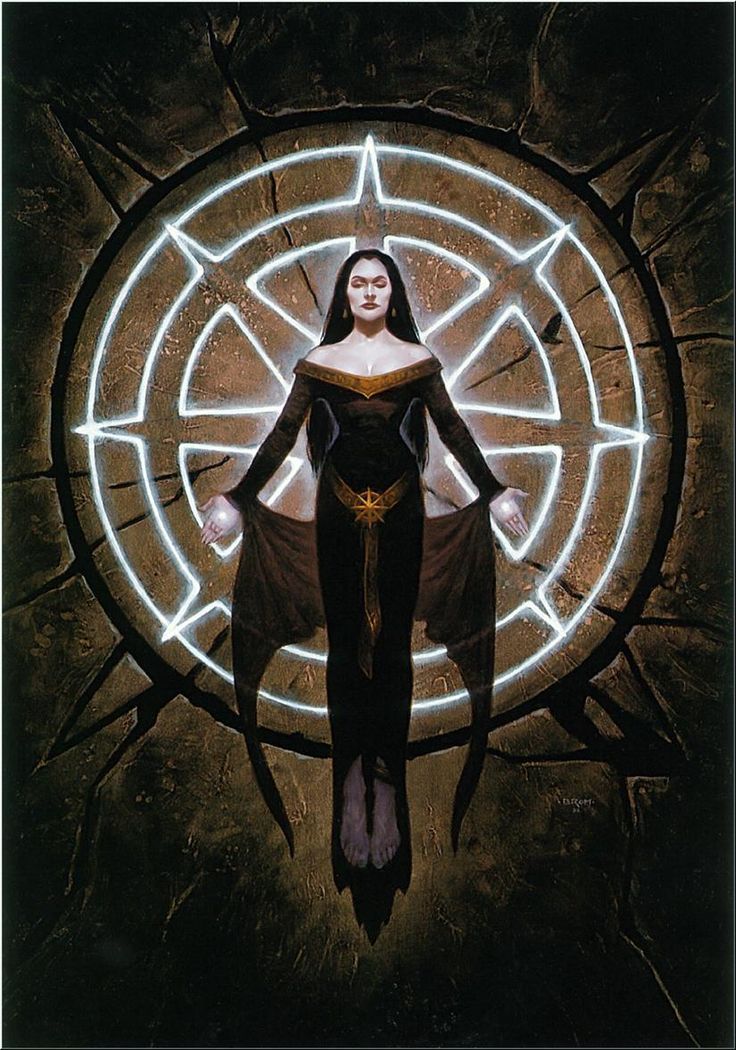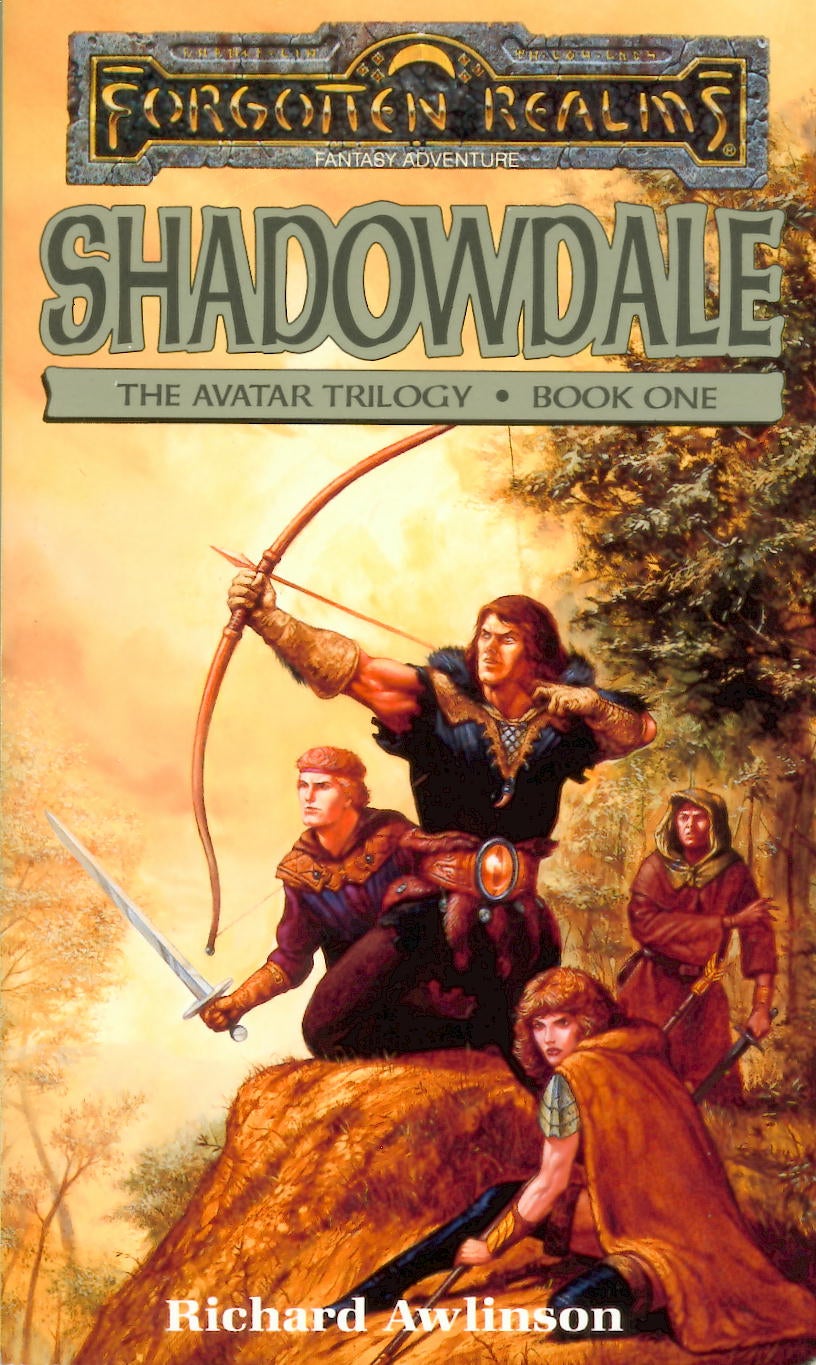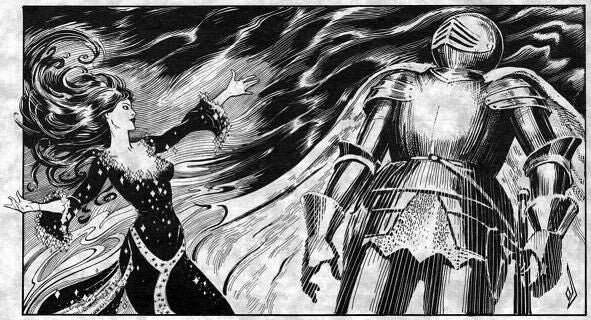You’d be forgiven for thinking Scott Ciencin’s 1989 Dungeons & Dragons novel Shadowdale primarily takes place in the city of Shadowdale. Or that Shadowdale would be mentioned at some point during the first half of the novel, or even that the main characters would enter Shadowdale before the 75% mark. You’d be wrong on all counts, but that doesn’t mean Shadowdale isn’t still the best D&D novel I’ve read (so far).
Shadowdale is part of the Avatar quintet, which I’m guessing was originally the Avatar trilogy, as the first three books were all published in the summer of ’89, while the last two came in ’93. Either way, they chronicle the “Time of Troubles,” which begins when a few of the gods steal the Tablets of Fate, angering Ao the Overgod so much he kicks all but one of the regular gods out of the Forgotten Realms equivalent of Heaven, stripping them of almost all of their powers and forcing them to become mortal.
This is a hell of a big premise for a D&D novel, but it doesn’t stop there. Because the gods are so diminished, their clerics can no longer cast spells — including healing spells — unless they’re within one mile of their deity’s mortal avatar. And since Mystra, the goddess who regulates magic, has been kicked to curb as well, magic no longer works correctly — as in, someone could try to cast a basic, 1st-level spell like Magic Missile and accidentally summon Cthulhu into the mortal plane. This renders everyone who doesn’t solve problems by punching them or stealing their money — i.e., two of AD&D: 2nd Edition’s four main character classes — useless.
The Time of Troubles is basically the first mega-event for the Forgotten Realms, a shake-up that would affect the game setting itself. But by bringing the gods to their knees and making them mortal, it means Shadowdale can still focus on a group of normal adventurers who slowly get wrapped up in a battle between Mystra and Bane, the (ex-)god of evil, with a natural progression. The adventuring party consists of (and I think I might do this as a list from hereon):
- Midnight, a mage who wakes up one day with a mysterious silver pendant grafted to her skin.
- Kelemvor, a sexist, misogynist warrior who is frequently an arsehole, and also cursed to turn into a panther if he ever helps someone without receiving a reward, which he’s super-bummed about.
- Cyric, a cynical thief.
- Adon, a cleric of the goddess of beauty who is incredibly vain about his looks (without cause) and kind of naïve but plenty confident in his battlehammer skills.

When a young waif named Caitlin begs for help rescuing her mistress, Kelemvor, Cyric, and Adon accept, but Kelemvor refuses to allow a woman on the team until Caitlin sees Midnight’s pendant and insists the sorceress come along. It’s a good thing because Midnight saves their collective asses multiple times throughout the course of the novel. As it turns out, the mistress who is imprisoned in Castle Kilgrave (sigh) is Mystra, who messed herself up so badly while trying to cast magic that Bane was able to imprison her. With help from the pendant — which contains part of Mystra’s divine power she was able to squirrel away before the arrival of the gods — Midnight is able to free the party from Bane’s psychological hallucinations, but also free the god of magic, too.
This helps less than you’d think. Mystra takes the pendant back and tries to use her slight bit of recovered divinity and knowledge of who stole the Tablets of Fate (I don’t want you to be shocked, but believe it or not, it was the God of Evil) to get back to Forgotten Realms heaven. Torm, the god of guardians whose job is to prevent the other gods from returning to full divinity, says only the Tablets’ return matters. Mystra tries to force her way in and Torm outright murders her. With her last bit of power, Mystra returns the pendant to Midnight and tasks her with heading to Shadowdale to find the Forgotten Realms’ most powerful sorcerer, Elminster, and then find the Tablets themselves.
Mystra’s death occurs at almost exactly the novel’s mid-point, so Shadowdale could really be two books: the rescue of Mystra, and then the journey to Shadowdale itself, which culminates with a giant battle against Bane and his fervent army of followers. Sometimes when fantasy novels make the switch from basic adventure to try to build to something epic, they stumble badly in the transition — Shadowdale doesn’t. It’s also a great adventure for Midnight and the crew to get to the city, because Mystra’s death has made magic even more chaotic, and messed up a huge swath of land the crew needs to travel through where mountains can suddenly turn to glass, rivers of blood spring up, fish swim through lava, there are giant boulders that look like frogs, etc.
This is also where the main character development takes place: Kelemvor and Midnight fall for each other (of course) and he becomes less of an arsehole, especially after his curse is revealed; Cyric becomes increasingly jealous of their relationship and starts to enjoy watching people die; and Adon gets a huge scar upon his face that challenges his entire perception of himself and world, rendering him completely nihilistic. Even Bane has to deal with human emotions and utters his first cry of grief when his most trusted minion dies.

So when the big battle does come, there’s no dawdling. Ciencin (Richard Awlinson was a pseudonym) gets right to the action, and it’s extremely satisfying to read about a group of smart, capable heroes kicking arse while still being outnumbered enough to give the fight stakes. Also, even an ex-god of evil has significant powers that Midnight, Elminster, and Adon must face. I actually liked Shadowdale so much I won’t spoil the ending, but suffice to say, there’s a solid cliffhanger that makes me look forward to reading Tantras, the next novel in the series.
Shadowdale is by no means perfect; while the characters have more depth than usual, they still aren’t that deep. Cyric’s increasing love of murder comes out of left field. Despite magic being a total mess, Midnight solves so many conflicts with it she repeatedly becomes a deus ex machina. There’s a character called Knightsbridge who’s clearly supposed to be Kelemvor’s main antagonist, but the character barely shows up and could have (and should have) been dropped. And again, it’s surprisingly Shadowdale-light. But Ciencin gets far more right than he gets wrong.
His pacing is great. His characters feel distinct, and they end up in different places than where they started, including the main villain. While Midnight is practically the only female character in the book other than Mystra, she’s never a damsel in distress; she’s utterly competent, an excellent fighter in her own right, and drives almost the entirety of the plot. Ciencin’s action is clear and compelling. He shows far more than he tells. Best of all, he can write scenes where nothing technically happens and still make them interesting, unlike many other D&D books, where it sounds like the characters are being forced to hang out with each other and make small talk.
This is not to say Shadowdale is on par with Game of Thrones or should be part of the pantheon of great fantasy or anything like that. But it feels like a real novel by a real novelist instead of a book by someone trying to be a novelist. Thus, even though I might be grading on a curve after the abysmal Greyhawk: Saga of Old City, Shadowdale rolls a 14 on the ol’ 1d20. And let me tell you this: some of the books I’ve read for “Dungeons & Dragons & Novels” have been out of curiosity, nostalgia, or obligation. When it comes time to read Tantras, I will be reading purely for pleasure. (And for work, technically.)

Assorted Musings:
- After Ao cast out the gods, he also destroyed many of the gods’ temples out of pique, and many priests were inside them at the time. Ao has zero compassion for or interest in humans whatsoever.
- Although Adon starts out as a self-absorbed goofball, he does have the line, “Find a city ruled by women and you will find true equality and fairness throughout the land.” Now, when he tells a waitress she should demand better treatment and more money for her work, the woman immediately gets fired because the Forgotten Realms is another patriarchal fantasy world. Of course, Adon is also fully confident he’s so attractive everyone wants to have sex with him as a matter of fact, but the former sentiment is nice.
- On the way to the castle, a ghoul attacks the party by tearing off its own head and throwing it at them. It’s an image that’s going to stick with me.
- Kelemvor’s weird curse actually started when one of his ancestors abandoned a witch to die, so she ensured the jerk could never accept a reward for helping people. Somehow that flip-flopped along the way, so Kel could only help people who gave him a reward. It’s weird.
- Tilverton is a town of blacksmiths who understandably worship Gorm, god of blacksmiths. Except they know Gorm’s avatar is living in another city and he’s refusing all their calls, which really messes with them emotionally. It’s weird, but it’s an interesting idea, and kind of funny.
- If Bane tried to gain access to D&D heaven, there is no reason I can see why he wouldn’t be equally and quickly as murdered as Mystra. It’s a bad plan, but Bane isn’t the sharpest evil tool in the shed.
- Alas, Scott Ciencin passed in 2014, only at age 51, of a blood clot. But he had a very prolific career.
- Next: It’s time to enter the world of Dragonlance in earnest with Margaret Weis and Tracy Hickman’s inaugural and beloved Dragons of Autumn Twilight.
